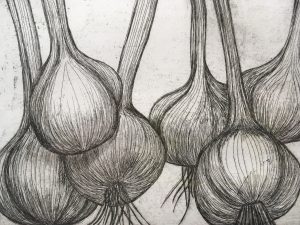Etching process
Etching is all about processes. You have to do things in the right order for the right amount of time in the right way. Once that’s established, you can then make it as simple or as complex as you like. This etching is an example of how simple it can be.
I’m not going to go through all the individual things you have to do to prepare the plate, except to explain the final one: rolling on what’s known as the “ground”. This is a bitumen wax layer you cover the plate with. This is what’s known as an “acid resist”. Once it’s cooled (you warm the plate before you roll it on), all you need to do is to start drawing. Where you draw (not scrape or scratch) is where you’ll be exposing the zinc to the diluted nitric acid – where the acid “bites” into the metal. And this is where – when it comes to the printing stage – that the ink needs to get into.
In this case, I did one line drawing, one acid exposure and it was ready to print.
Next step? I’ll add an aquatint background.

